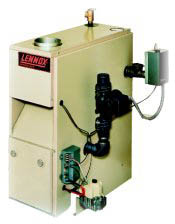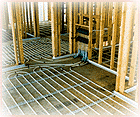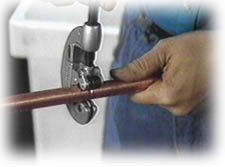 A hot water boiler heats water which moves through a system of piping and delivers heat using radiators, baseboard, or radiant convection systems. Gravity simply means that the energy from the heat forces the hot water to move out of the boiler, like in a steam system, forcing the cooler water back into the boiler for reheating. Most hot water systems today are forced systems using circulator pumps to move the water through one or more zones. Most modern homes have multiple zones for maximum efficiency and effectiveness. A popular newer form of distribution using hot water is hydronic forced air. In this system the water is delivered to a coil in a duct. A fan blows on the hot coil to move air across it and deliver the warm air to the rooms through registers. This is often seen when the duct system is also used for air conditioning and saves on the installation of a separate distribution system for the heat.
A hot water boiler heats water which moves through a system of piping and delivers heat using radiators, baseboard, or radiant convection systems. Gravity simply means that the energy from the heat forces the hot water to move out of the boiler, like in a steam system, forcing the cooler water back into the boiler for reheating. Most hot water systems today are forced systems using circulator pumps to move the water through one or more zones. Most modern homes have multiple zones for maximum efficiency and effectiveness. A popular newer form of distribution using hot water is hydronic forced air. In this system the water is delivered to a coil in a duct. A fan blows on the hot coil to move air across it and deliver the warm air to the rooms through registers. This is often seen when the duct system is also used for air conditioning and saves on the installation of a separate distribution system for the heat.
 Baseboard
Baseboard
Baseboard convectors can be used for either steam or hot water. They can be run along the walls in portions of the rooms and when installed correctly supply a very even method of heat distribution. Baseboard is used in steam, usually when old cast iron radiators are removed. The professional inspector must check carefully to make certain there is heat in every room that is functional. If too much baseboard is installed then the rooms farther from the heating plant will not get adequate heat. If too little is installed then many of the rooms may be too cool or the system will not be efficient. Proper installation of the system is important to keep maintenance to a minimum.
 Radiant
Radiant
Radiant forced hot water is becoming popular again. Piping is installed in either the floor or ceiling and warms the areas where they are installed. Although this is not the most efficient installation, it is the most cosmetically appealing because the convection piping is not visible and it is the most comfortable when installed correctly. Older systems used copper tubing in the slab of the home to warm it like a hot plate. These systems however are prone to expensive maintenance after 20 or more years. When a leak occurs it is both difficult to locate or repair. Many of the these installations have been converted to baseboard convection because of costly repairs. Most modern installations use industrial plastic tubing which will be more durable than the previous copper tubing installations.
 Radiators
Radiators
Radiators are used in either steam or hot water systems. They are usually seen only in older homes. Steam radiators look the same as hot water radiators except there is a steam check valve on them. This valve allows air out of the radiator when steam comes in and closes to prevent the steam from escaping. The inspector checks these radiators carefully because they can be prone to air binding, leaks and bad valves. Converting radiator systems to baseboard systems can be much more expensive than anticipated depending on the original piping installation.
 Piping
Piping
The piping system in a hot water or steam hydronic heating system delivers the heated element to the final convector used to exchange the heat. Pipes are usually made of steel, iron or copper. A proper design and installation of the piping system is crucial for the efficient and proper operation of your new homes heating system. Many older piping systems can be corroded or difficult to alter. They can also have asbestos, a commonly known health hazard, insulation. Most heat piping defects go undetected until a trained professional inspects the system.